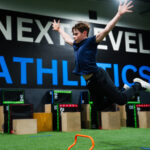Speed and Agility Training for Lacrosse Players
Lacrosse is one of the fastest games on two feet. To excel, athletes need speed, quick changes of direction, and the agility to navigate a chaotic, physical field.
In this article, you’ll discover how to build a lacrosse-specific speed and agility training plan that makes you quicker off the line, sharper in transitions, and more elusive with the ball.
Why Lacrosse Requires Elite Speed and Agility
Whether you’re a midfielder, attacker, or defender, lacrosse demands a unique blend of physical traits:
Quick Acceleration
Lacrosse players are constantly bursting into sprints—off the draw, during clears, or chasing ground balls. Rapid Directional Changes, Dodging defenders, cutting into space, or switching directions on defense happens constantly.
Decision-Making on the Move
Success requires being fast, and being fast with purpose.
👟 Footwork Under Pressure
Lacrosse players must move efficiently while dodging checks, staying in bounds, or tracking cutters.
According to the NSCA, sport-specific agility training enhances both physical performance and tactical execution in team sports like lacrosse.
Key Components of Speed and Agility for Lacrosse
To create a balanced program, focus on the following elements:
✅ Acceleration Mechanics
Players need to reach top speed quickly, often in less than five steps.
✅ Lateral Agility
Cutting, shuffling, and closing down space are essential in both offense and defense.
✅ Deceleration and Reacceleration
Stopping under control and bursting again is vital for transition play.
✅ Reactive Movement
In games, movement is dictated by the opponent or the ball. Your training should mimic that.
Best Speed and Agility Drills for Lacrosse Players
These drills combine linear sprinting, lateral movement, and reactive elements to replicate game demands.
1. 5-10-5 Shuttle Drill
How:
-
Place cones 5 yards apart.
-
Sprint 5 yards right, then 10 left, and 5 back to start.
Focus: Quick lateral change of direction
Reps: 3–5 sets, 1-minute rest
2. Reaction Sprint with Ball Pickup
How:
-
Partner gives a visual cue (point left or right).
-
Sprint to designated cone and scoop a ground ball.
Focus: Acceleration, vision, and reactive movement
Reps: 5 reps each direction
3. Zig-Zag Cone Cuts
How:
-
Set cones 5 yards apart in a zig-zag.
-
Sprint through, cutting tightly around each.
Focus: Lateral speed and body control
Reps: 3–4 rounds
4. Crossover Sprint Drill
How:
-
Start in a shuffle.
-
Transition into a crossover step and sprint.
Focus: Defensive footwork into offensive movement
Reps: 4 sets per side
5. Mirror Movement Drill
How:
-
Partner leads movement: forward, backward, lateral.
-
Athlete mirrors every movement.
Focus: Reactive footwork and decision-making
Reps: 3 rounds of 30 seconds
Weekly Speed and Agility Routine for Lacrosse
Here’s a sample 3-day plan to balance intensity and recovery:
Monday – Acceleration & Footwork
-
Dynamic warm-up + mobility
-
5-10-5 drill – 4 sets
-
Crossover sprint drill – 4 sets
-
Jump rope (quick feet) – 3 rounds of 30 sec
-
Core: Deadbugs + V-ups – 3×15
Wednesday – Reactive Agility Focus
-
Warm-up jog + ladder footwork
-
Mirror drill – 3 rounds
-
Reaction sprint w/ ball – 4 sets
-
Lateral hurdle hops – 3 sets
-
Static stretching + breath work
Friday – Game Simulation & Power
-
Cone zig-zag drill – 3 rounds
-
Hill sprints (if available) – 6 x 15 yards
-
3v2 or 1v1 dodging scenarios
-
Wall ball or stick work under fatigue
-
Cool down jog
Equipment to Enhance Lacrosse Agility Workouts
Speed and agility training doesn’t require a full gym. Here’s what’s helpful:
-
Cones for cutting and shuttle drills
-
Agility ladder for foot speed
-
Resistance bands (optional for resisted sprints)
-
Reaction lights or signals
-
Lacrosse balls and stick for realistic drills
Common Mistakes in Lacrosse Agility Training
Here are some key pitfalls to avoid:
-
Only sprinting straight: Lacrosse is multidirectional—add lateral and curved runs.
-
No reactive element: Use partners or cues to simulate the game’s unpredictability.
-
Skipping deceleration drills: Controlled stopping reduces injury risk and improves movement quality.
-
Neglecting rest: Speed training must be done when fresh—build in recovery.
Why It Matters for All Positions
Attackmen
-
Improve dodge quickness
-
Create separation from defenders
Midfielders
-
Boost transition speed
-
Control space in both ends
Defenders
-
Improve lateral movement
-
Close down and recover faster
Goalies
(See Goalkeeper Speed and Agility Training for full breakdown.)
Unlock Your Speed with Next Level Athletics
Lacrosse is a speed-driven sport. At Next Level Athletics USA, we offer athlete-tested speed and agility programs built for high-performance lacrosse players. Our methods improve movement quality, foot speed, and reaction timing—whether you’re prepping for high school, college, or club competition.
Final Thoughts
Speed and agility training can transform your game. With better reaction time, sharper cuts, and faster acceleration, you’ll become more dynamic on the field—and more dangerous with or without the ball.
Lacrosse isn’t just about stick skills. It’s about movement. Train smart, move fast, and dominate your matchup.


Recent Comments